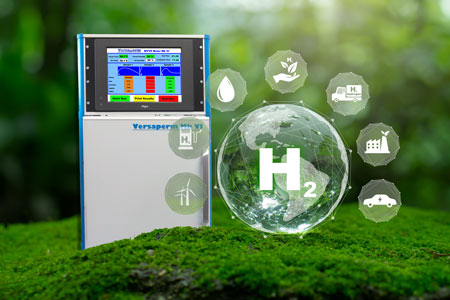Hydrogen vapour permeability and semiconductors
 In semiconductor manufacturing, hydrogen vapor permeability plays a crucial role due to the widespread use of hydrogen in various processes, especially in environments requiring controlled atmospheres. Understanding and managing hydrogen permeability is essential to ensuring the integrity of sensitive processes and materials involved in chip fabrication. Here's a detailed look at how hydrogen vapor permeability impacts semiconductor manufacturing: In semiconductor manufacturing, hydrogen vapor permeability plays a crucial role due to the widespread use of hydrogen in various processes, especially in environments requiring controlled atmospheres. Understanding and managing hydrogen permeability is essential to ensuring the integrity of sensitive processes and materials involved in chip fabrication. Here's a detailed look at how hydrogen vapor permeability impacts semiconductor manufacturing:
1. Hydrogen as a reducing atmosphere
- Annealing Processes: Hydrogen is used in annealing to remove oxide layers from wafers, particularly silicon wafers, and to improve the crystal quality of semiconductors. Annealing in a hydrogen atmosphere reduces surface defects, but maintaining precise control of the hydrogen environment is essential. Materials used in annealing chambers and reactors need low hydrogen permeability to maintain the controlled atmosphere and prevent the hydrogen from diffusing out, which could lead to process instability and defects.
- Hydrogen in heat treatment: During thermal processing, hydrogen may also be used to maintain a reducing atmosphere to prevent oxidation. Components of the heat treatment equipment (e.g., quartz tubes, seals, or enclosures) must resist hydrogen permeation to preserve the desired gas environment.
2. Hydrogen in epitaxial growth
- In epitaxy, a process critical for growing crystalline layers on semiconductor wafers (such as silicon or gallium arsenide), hydrogen is used as a carrier gas to transport precursor gases and to create a reducing environment that prevents unwanted reactions. The permeability of materials in epitaxial reactors must be controlled to avoid contamination and the unintended escape of hydrogen, which could compromise the uniformity and quality of the epitaxial layer.
3. Plasma-Enhanced Chemical Vapor Deposition (PECVD)
- PECVD uses hydrogen or hydrogen-containing gases (like silane and ammonia) to deposit thin films of materials such as silicon nitride or silicon oxide. In this process, hydrogen plays a role in breaking down precursor gases and facilitating film growth. Equipment used in PECVD processes must be designed with materials that prevent hydrogen permeation, as leakage or excessive hydrogen exposure can affect the deposition quality, film uniformity, and result in undesired hydrogen-related defects.
4. Hydrogen in dry etching and cleaning
- Hydrogen is also employed in dry etching and plasma cleaning processes, where it helps remove unwanted layers from the wafer surface. For example, hydrogen chloride (HCl) can be used for etching silicon-based materials. In such processes, the components of the etching chambers and related systems must have controlled hydrogen permeability to prevent hydrogen leakage and maintain the desired concentration of etchants. Uncontrolled hydrogen permeation can lead to inconsistent etching rates and surface damage.
5. Hydrogen in device passivation
- Passivation is used to protect semiconductor devices, such as transistors and diodes, by coating them with a protective layer. Hydrogen is involved in the passivation process to neutralize dangling bonds at the silicon surface, which improves device performance and stability. In this process, the containment materials must be designed to manage hydrogen permeability effectively to ensure proper hydrogenation and surface passivation without unwanted diffusion of hydrogen that could degrade device performance.
 6. Hydrogen permeability in vacuum systems 6. Hydrogen permeability in vacuum systems
- In many semiconductor manufacturing steps, processes are carried out in ultra-high vacuum (UHV) environments, where hydrogen outgassing from materials can be a significant concern. Hydrogen, due to its small molecular size, can permeate through many materials, even in vacuum systems, leading to contamination of the process environment. In vacuum chambers used in semiconductor fabrication, materials with low hydrogen permeability (such as stainless steel or specially treated polymers) are crucial to prevent hydrogen from entering or leaking out, which can compromise the purity of the vacuum and affect process outcomes, such as thin film deposition or etching precision.
7. Hydrogen in doping and ion implantation
- Hydrogen is also used in ion implantation, where it helps introduce dopants into the semiconductor material to modify its electrical properties. Controlling hydrogen permeability in the materials used in ion implanters is critical because excessive hydrogen diffusion can cause unintended doping concentrations, leading to poor device performance or yield loss.
8. Impact on semiconductor device performance
- In some semiconductor devices, such as metal-oxide-semiconductor field-effect transistors (MOSFETs), hydrogen can interact with gate oxides and silicon interfaces, which can improve performance by passivating surface defects. However, excessive or uncontrolled hydrogen permeation can lead to degradation over time (e.g., hydrogen-induced oxidation or diffusion into sensitive areas), impacting the long-term reliability of devices. Materials used in these processes need to have a well-defined hydrogen permeability profile to ensure precise control over the hydrogen environment.
9. Packaging and encapsulation of semiconductor devices
- Hydrogen can also permeate through the encapsulation materials used in semiconductor packaging, especially in moisture-sensitive devices. For instance, in LEDs or high-performance transistors, the packaging must be designed to minimize hydrogen diffusion to prevent degradation of the device’s electrical and optical properties over time. The choice of encapsulation materials with low hydrogen permeability is critical for ensuring the longevity and reliability of semiconductor devices in various applications.
Challenges and importance of hydrogen vapor permeability control:
- Material selection: Different materials used in semiconductor manufacturing equipment (e.g., polymers, metals, ceramics) must be selected based on their hydrogen permeability characteristics. For instance, polymers often have higher hydrogen permeability than metals, making them less suitable for certain high-precision processes unless treated with coatings.
- Hydrogen-induced defects: If not properly managed, hydrogen permeation can lead to defects such as blistering, delamination, or contamination of semiconductor materials, significantly affecting yield and performance.
Conclusion
In conclusion, managing hydrogen vapor permeability is critical in semiconductor manufacturing to maintain the integrity of processes such as deposition, etching, annealing, and doping, and to ensure that hydrogen does not adversely affect the final semiconductor device quality.
| 

![]() In semiconductor manufacturing, hydrogen vapor permeability plays a crucial role due to the widespread use of hydrogen in various processes, especially in environments requiring controlled atmospheres. Understanding and managing hydrogen permeability is essential to ensuring the integrity of sensitive processes and materials involved in chip fabrication. Here's a detailed look at how hydrogen vapor permeability impacts semiconductor manufacturing:
In semiconductor manufacturing, hydrogen vapor permeability plays a crucial role due to the widespread use of hydrogen in various processes, especially in environments requiring controlled atmospheres. Understanding and managing hydrogen permeability is essential to ensuring the integrity of sensitive processes and materials involved in chip fabrication. Here's a detailed look at how hydrogen vapor permeability impacts semiconductor manufacturing: 6. Hydrogen permeability in vacuum systems
6. Hydrogen permeability in vacuum systems